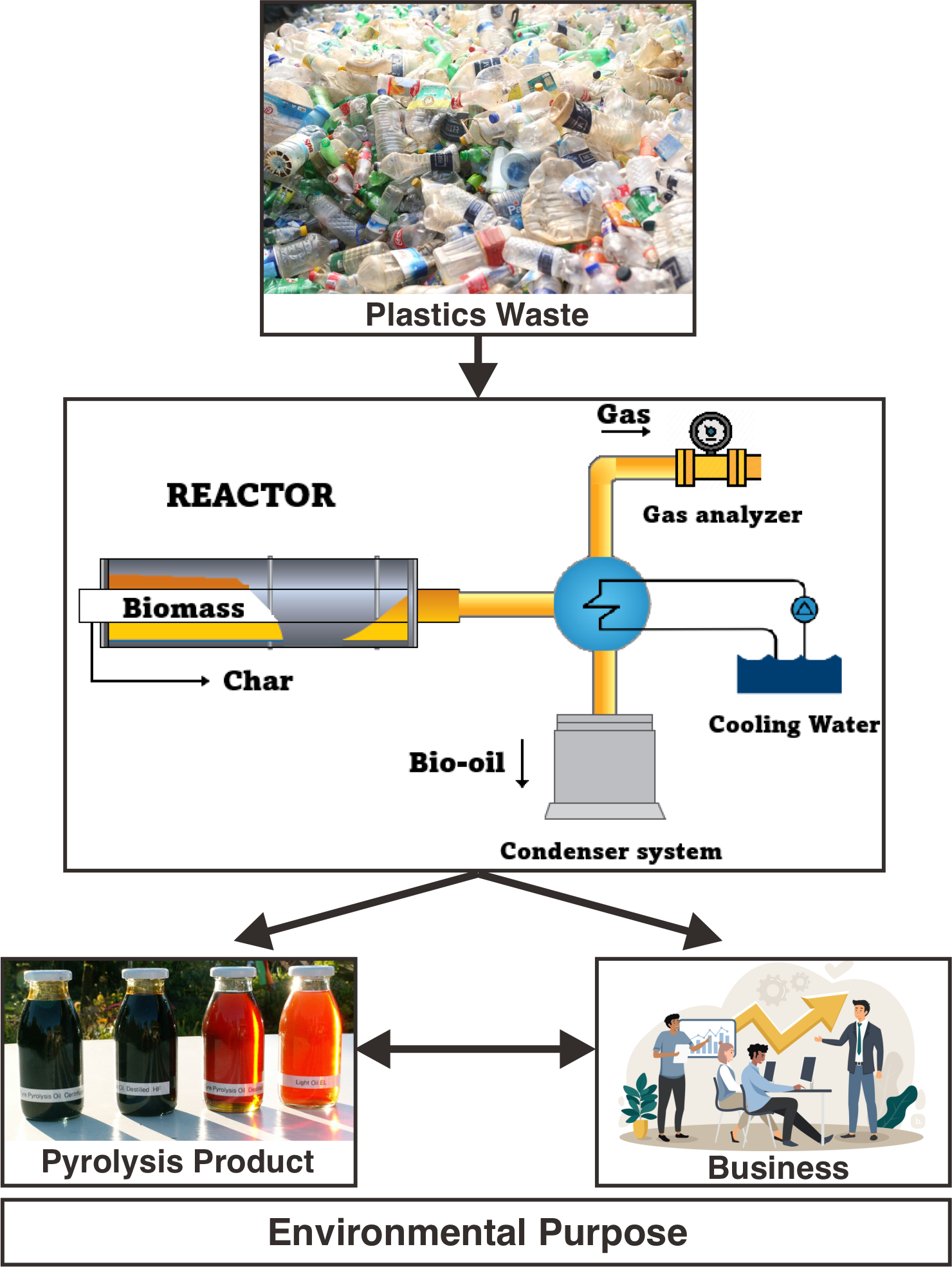Pyrolysis for plastic waste: Environmental goals vs business interests, which is more realistic?
Main Article Content
Abstract
Global plastic production exceeds 390 million tons annually, yet only about 9% is recycled, leaving severe environmental impacts. Pyrolysis is emerging as a promising solution, converting plastic waste into fuels and chemicals. However, popular claims on mass media and commercial technology publications, that 1 kg of plastic yields 1 liter of fuel are misleading, as they ignore differences in mass, volume, and fuel density. Pyrolysis oil can indeed serve as fuel but often needs further refining to meet engine standards. Economically, it holds potential, with oil prices ranging from USD 600–900 per ton and syngas generating up to 800 kWh per ton. Nonetheless, high capital and operational costs challenge its feasibility, particularly for small-scale operations. Environmentally, pyrolysis aligns with sustainability and circular economy goals, potentially reducing emissions by up to 3.5 tons of CO₂-equivalent per ton of plastic processed. This paper examines pyrolysis critically, addressing misconceptions and evaluating its realistic prospects as both an environmental solution and a business venture.
Downloads
Article Details

This work is licensed under a Creative Commons Attribution-NonCommercial 4.0 International License.
References
[2] R. Geyer, J. R. Jambeck, and K. L. Law, “Production, use, and fate of all plastics ever made,” Science Advances, vol. 3, no. 7, p. e1700782, Jul. 2017, doi: 10.1126/sciadv.1700782.
[3] R. Miandad, M. A. Barakat, M. Rehan, A. S. Aburiazaiza, I. M. I. Ismail, and A. S. Nizami, “Plastic waste to liquid oil through catalytic pyrolysis using natural and synthetic zeolite catalysts,” Waste Management, vol. 69, pp. 66–78, 2017, doi: 10.1016/j.wasman.2017.08.032.
[4] S. Sunaryo, S. Sutoyo, S. Suyitno, Z. Arifin, T. Kivevele, and A. I. Petrov, “Characteristics of briquettes from plastic pyrolysis by-products,” Mechanical Engineering for Society and Industry, vol. 3, no. 2, pp. 57–65, Jun. 2023, doi: 10.31603/mesi.9114.
[5] G. Plastic, “Get plastic foundation - no plastic goes to waste,” Jul. 2025. [Online]. Available: https://getplastic.id/
[6] Kementerian ESDM Republik Indonesia, “Premium dari limbah plastik,” Jul. 2025. [Online]. Available: https://www.esdm.go.id/id/media-center/arsip-berita/premium-dari-limbah-plastik
[7] Mordor Intelligence, “Pyrolysis Oil market - price, companies & manufacturers.” [Online]. Available: https://www.mordorintelligence.com/industry-reports/pyrolysis-oil-market
[8] W. Fong-Silva, R. Pitre-Redondo, and J. Chiquillo-Rodelo, “Business competitiveness and its association with exogenous factors in plastic recycling companies of the Colombian Caribbean coast,” Contemporary Engineering Sciences, vol. 11, no. 2, pp. 71–79, 2018, doi: 10.12988/ces.2018.711190.
[9] A. Fivga and I. Dimitriou, “Pyrolysis of plastic waste for production of heavy fuel substitute: A techno-economic assessment,” Energy, vol. 149, pp. 865–874, 2018, doi: 10.1016/j.energy.2018.02.094.
[10] T. Xayachak, N. Haque, D. Lau, R. Parthasarathy, and B. K. Pramanik, “Assessing the environmental footprint of plastic pyrolysis and gasification: A life cycle inventory study,” Process Safety and Environmental Protection, vol. 173, pp. 592–603, 2023, doi: 10.1016/j.psep.2023.03.061.
[11] L. Pires Costa, D. M. Vaz de Miranda, and J. C. Pinto, “Critical Evaluation of Life Cycle Assessment Analyses of Plastic Waste Pyrolysis,” ACS Sustainable Chemistry & Engineering, vol. 10, no. 12, pp. 3799–3807, Mar. 2022, doi: 10.1021/acssuschemeng.2c00265.
[12] Ł. Grabowski, M. Gliniak, M. Wołosiewicz-Głąb, and K. Dziedzic, “Possibilities of Using the Hydrocarbon Fraction from the Depolymerization Process for Combined Heat and Power Systems,” Energy & Fuels, vol. 31, no. 3, pp. 2914–2918, Mar. 2017, doi: 10.1021/acs.energyfuels.6b03024.
[13] S. McIntosh, M. N. Nabi, L. Moghaddam, P. Brooks, P. S. Ghandehari, and D. Erler, “Combined pyrolysis and sulphided NiMo/Al2O3 catalysed hydroprocessing in a multistage strategy for the production of biofuels from milk processing waste,” Fuel, vol. 295, p. 120602, Jul. 2021, doi: 10.1016/j.fuel.2021.120602.
[14] S. H. Masakhoh et al., “Pyrofuel extraction from polyethylene terephthalate (PET) plastic waste,” in International Symposium on Advanced Materials and Processing 2021 (ISAMP 2021), 2022, p. 040001. doi: 10.1063/5.0090704.
[15] G. Lopez, M. Artetxe, M. Amutio, J. Alvarez, J. Bilbao, and M. Olazar, “Recent advances in the gasification of waste plastics. A critical overview,” Renewable and Sustainable Energy Reviews, vol. 82, pp. 576–596, 2018, doi: 10.1016/j.rser.2017.09.032.
[16] M. M. Hasan, R. Haque, M. I. Jahirul, and M. G. Rasul, “Pyrolysis of plastic waste for sustainable energy Recovery: Technological advancements and environmental impacts,” Energy Conversion and Management, vol. 326, p. 119511, Feb. 2025, doi: 10.1016/j.enconman.2025.119511.
[17] S. Saxena, “Pyrolysis and beyond: Sustainable valorization of plastic waste,” Applications in Energy and Combustion Science, vol. 21, p. 100311, Mar. 2025, doi: 10.1016/j.jaecs.2024.100311.
[18] S. R. Khan, M. Zeeshan, S. Fatima, D. Ciolkosz, I. Dimitriou, and H. Jin, “A comparative techno-economic analysis of combined oil and power production from pyrolysis and co-pyrolysis plants utilizing rice straw and scrap rubber tires,” Fuel, vol. 348, p. 128639, Sep. 2023, doi: 10.1016/j.fuel.2023.128639.
[19] B. Biakhmetov, Y. Li, Q. Zhao, A. Dostiyarov, D. Flynn, and S. You, “Transportation and process modelling-assisted techno-economic assessment of resource recovery from non-recycled municipal plastic waste,” Energy Conversion and Management, vol. 324, p. 119273, Jan. 2025, doi: 10.1016/j.enconman.2024.119273.
[20] S. Das, C. Liang, and J. B. Dunn, “Plastics to fuel or plastics: Life cycle assessment-based evaluation of different options for pyrolysis at end-of-life,” Waste Management, vol. 153, pp. 81–88, Nov. 2022, doi: 10.1016/j.wasman.2022.08.015.
[21] H. Jeswani et al., “Life cycle environmental impacts of chemical recycling via pyrolysis of mixed plastic waste in comparison with mechanical recycling and energy recovery,” Science of The Total Environment, vol. 769, p. 144483, May 2021, doi: 10.1016/j.scitotenv.2020.144483.
[22] X. Li et al., “Review of Co-Pyrolysis Technologies of Typical Plastic and Biomass Waste for Value-Added Products,” Research of Environmental Sciences, vol. 36, no. 9, pp. 1765–1778, 2023, doi: 10.13198/j.issn.1001-6929.2023.08.01.
[23] C. Stallkamp et al., “Economic and environmental assessment of automotive plastic waste end‐of‐life options: Energy recovery versus chemical recycling,” Journal of Industrial Ecology, vol. 27, no. 5, pp. 1319–1334, Oct. 2023, doi: 10.1111/jiec.13416.

